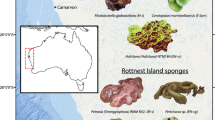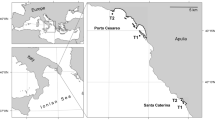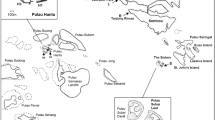Abstract
This first assessment of sponges on Australia’s deep western continental margin (100–1,100 m) found that highly species-rich sponge assemblages dominate the megabenthic invertebrate biomass in both southwestern (86%) and northwestern (35%) areas. The demosponge orders Poecilosclerida, Dictyoceratida, Haplosclerida, and Astrophorida are dominant, while the presence of the order Agelasida, lithistid sponges, and the Verongida are noteworthy in providing contrasts to other studies from the deep temperate Australian margin. Most sponge species appeared to be rare as two-thirds were present in only one or two samples—a finding consistent with studies of the shallow Australian sponge fauna. The Demospongiae and Calcarea had similar distribution and abundance patterns being found in the greatest numbers in the south on the outer shelf and shelf edge in hard substrates. In contrast, the Hexactinellida were more abundant at deeper depths and in soft substrates, and were more common in the north. Although the environmental factors that influence sponge distributions on the western margin cannot be completely understood from the physical covariates analyzed in this study, the data suggest depth-related factors, substrate type, and current regimes are the most influential. Incompletely documented historic demersal trawling may partly account for the lower sponge biomass found in the north. The potentially high importance of sponges to benthic ecosystems, as well as the potential for high impacts on sponges by bottom trawling, indicates that maintaining healthy sponge assemblages should be an important consideration for marine conservation planners. Successful management will need to be under-pinned by additional research that better identifies the ecological roles of sponges, and their distributions over local and broad environmental scales.





Similar content being viewed by others
References
Althaus, F., A. William, R. J. Kloser, J. Seiler & N. J. Bax, 2011. Evaluating geomorphic features as surrogates for benthic biodiversity on Australia’s western continental margin. In Harris, P. (ed.), Seafloor Geomorphology as Benthic Habitat: GeoHab Atlas of Seafloor Geomorphic Features and Benthic Habitats. http://geohab.org/atlas.html. Accessed on 9 Aug 2011.
Anderson, M. J., R. N. Gorley & K. R. Clarke, 2008. PERMANOVA+ for PRIMER: Guide to Software and Statistical Methods. PRIMER-E, Plymouth, UK: 214 pp.
Buhl-Mortensen, L., A. Vanreusel, A. J. Gooday, L. A. Levin, I. G. Priede, P. Buhl-Mortensen, H. Gheerardyn, N. J. King & M. Raes, 2010. Biological structures as a source of habitat heterogeneity and biodiversity on the deep ocean margins. Marine Ecology – An Evolutionary Perspective 31: 21–50.
Clark, M. R., F. Althaus, A. Williams, E. Niklitschek, G. M. Menezes, N.-R. Hareide, P. Sutton & C. O’Donnell, 2010. Are deep-sea demersal fish assemblages globally homogenous? – insights from seamounts. Marine Ecology – An Evolutionary Perspective 31(Suppl. 1): 39–51.
Clarke, K. R., 1993. Non-parametric multivariate analyses of changes in community structure. Australian Journal of Ecology 18(1): 117–143.
Clarke, K. R. & R. N. Gorley, 2006. PRIMER-e v6: User Manual/Tutorial. Primer-E, Plymouth.
Commonwealth of Australia, 2005. National Marine Bioregionalisation of Australia. Department of the Environment and Heritage, Geoscience Australia, CSIRO Marine Research. National Oceans Office, Canberra, ISBN 1-877043-61-3.
Dunn, J. R. & K. R. Ridgway, 2002. Mapping ocean properties in regions of complex topography. Deep-Sea Research Part I-Oceanographic Research Papers 49: 591–604.
Feng, M., D. Slawinski, L. E. Beckley & J. K. Keesing, 2010. Retention and dispersal of shelf waters influenced by interactions of ocean boundary current and coastal geography. Marine and Freshwater Research 61: 1259–1267.
Forest, J., 1981. Compte rendu et remarques générales (texte bilingue)/Report and general comments (bilingual text). Résultats des campagnes MUSORSTOM, 1, Mémoires ORSTOM (Office de la Recherche Scientifique et Technique Outre-Mer): 91 pp.
Fromont, J. & M. A. Vanderklift, 2009. Porifera (sponges) of Mermaid Reef (Rowley Shoals), Scott and Seringapatam Reefs, Western Australia. Records of the Western Australian Museum. Supplement 77: 89–104.
Fromont, J., M. A. Vanderklift & G. A. Kendrick, 2006. Marine sponges of the Dampier Archipelago, Western Australia: patterns of species distributions, abundance and diversity. Biodiversity and Conservation 15: 3731–3750.
Fromont, J., K. L. Usher, D. C. Sutton, S. Toze & J. Kuo, 2008. Species of the sponge genus Chondrilla (Demospongiae: Chondrosida: Chondrillidae) in Australia. Records of the Western Australian Museum 24(4): 469–486.
Grassle, J. F. & N. J. Maciolek, 1992. Deep-sea species richness – regional and local diversity estimates from quantitative bottom samples. American Naturalist 139: 313–341.
Gray, J. S., A. Bjoergesaeter & K. I. Ugland, 2005. The impact of rare species on natural assemblages. Journal of Animal Ecology 74: 1131–1139.
Hanson, C. E., S. Pesant, A. M. Waite & C. B. Pattiaratchi, 2007. Assessing the magnitude and significance of deep chlorophyll maxima of the coastal eastern Indian Ocean. Deep-Sea Research Part II-Topical Studies in Oceanography 54: 884–901.
Hogg, M. M., O. S. Tendal, K. W. Conway, S. A. Pomponi, R. W. M. van Soest, J. Gutt, M. Krautter & J. M. Roberts, 2010. Deep-Sea Sponge Grounds: Reservoirs of Biodiversity, UNEP-WCMC Biodiversity Series No. 32. UNEP-WCMC, Cambridge, UK.
Hooper, J. N. A. & J. A. Kennedy, 2002. Small-scale patterns of sponge biodiversity (Porifera) on Sunshine Coast reefs, eastern Australia. Invertebrate Systematics 16: 637–653.
Howell, K. L., J. S. Davies & B. E. Narayanaswamy, 2010. Identifying deep-sea megafaunal epibenthic assemblages for use in habitat mapping and marine protected area network design. Journal of the Marine Biological Association of the United Kingdom 90: 33–68.
Huang, Z., B. Brooke & J. Li, 2011. Performance of predictive models in marine benthic environments based on predictions of sponge distribution on the Australian continental shelf. Ecological Informatics 6: 205–216.
Jimenez, E. & M. Ribes, 2007. Sponges as a source of dissolved inorganic nitrogen: nitrification mediated by temperate sponges. Limnology and Oceanography 52: 948–958.
Last, P. R., V. D. Lyne, A. Williams, C. R. Davies, A. J. Butler & G. K. Yearsley, 2010. A hierarchical framework for classifying seabed biodiversity with application to planning and managing Australia’s marine biological resources. Biological Conservation 143: 1675–1686.
Legendre, P. & M. J. Anderson, 1999. Distance-based redundancy analysis: testing multi-species responses in multifactorial ecological experiments. Ecological Monograph 69: 1–24.
Lewis, M., 1999. CSIRO-SEBS (Seamount, Epibenthic Sampler), a new epibenthic sled for sampling seamounts and other rough terrain. Deep-Sea Research I 46: 1101–1107.
Lewis, M., 2009. Sherman the epibenthic sled for rough terrain (CSIRO Marine and Atmospheric Research paper; 029). CSIRO Marine and Atmospheric Research, Canberra, ACT: 15 pp.
Lewis, M., 2010. The CSIRO 4m Beam Trawl (CSIRO Marine and Atmospheric Research Paper 033). CSIRO Marine and Atmospheric Research, Hobart, Tas: 17 pp.
Lourey, M. J., J. R. Dunn & J. Waring, 2006. A mixed-layer nutrient climatology of Leeuwin Current and western Australian shelf waters: seasonal nutrient dynamics and biomass. Journal of Marine Systems 59: 25–51.
Maldonado, M. & M. J. Uriz, 1999. Sexual propagation by sponge fragments. Nature 398: 476.
Maldonado, M., A. Riesgo, A. Bucci & K. Rutzler, 2010. Revisiting silicon budgets at a tropical continental shelf: silica standing stocks in sponges surpass those in diatoms. Limnology and Oceanography 55: 2001–2010.
McEnnulty, F. R., K. L. Gowlett-Holmes, A. Williams, F. Althaus, J. Fromont, G. C. B. Poore, T. D. O’Hara, L. Marsh, P. Kott, S. Slack-Smith, P. Alderslade, & M. V. Kitahara, 2011. The deepwater megabenthic invertebrates on the western continental margin of Australia (100–1100 m depths): composition, distribution and novelty. Records of Western Australian Museum Supplement 80: 1–189.
McQuillan, L., 2006. Species richness, density and cover of sponges on temperate reefs in Western Australia. Unpublished MSc thesis, Edith Cowan University.
Meuleners, M. J., C. B. Pattiaratchi & G. N. Ivey, 2007. Numerical modelling of the mean flow characteristics of the Leeuwin Current System. Deep-Sea Research Part II-Topical Studies in Oceanography 54: 837–858.
North West Shelf Joint Environmental Management Study, 2007. CSIRO and Department of the Environment of Western Australia: 40 pp.
Reed, J. K. & S. A. Pomponi, 1997. Biodiversity and distribution of deep and shallow water sponges in the Bahamas. In Proceedings of the Eighth International Coral Reef Symposium, Panama, June 24–29, 1996: 1387–1392.
Ridgway, K. R. & S. A. Condie, 2004. The 5500-km-long boundary flow off western and southern Australia. Journal of Geophysical Research-Oceans 109: 18 pp.
Ridgway, K. R., J. R. Dunn & J. L. Wilkin, 2002. Ocean interpolation by four-dimensional least squares – application to the waters around Australia. Journal of Atmospheric and Oceanic Technology 19: 1357–1375.
Riisgard, H. U. & P. S. Larsen, 2010. Particle capture mechanisms in suspension-feeding invertebrates. Marine Ecology-Progress Series 418: 255–293.
Rützler, K., 2004. Sponges on coral reefs: a community shaped by competitive cooperation. In Pansini, M., R. Pronzato, G. Bavestrello & R. Manconi (eds), Sponge Science in the New Millennium. Officine Grafiche Canessa, Rapallo, Genova: 85–148.
Sainsbury, K. J., 1987. Assessment and management of the demersal fishery on the continental shelf of northwestern Australia. In Polovina, J. J. & S. Ralston (eds), Tropical snappers and groupers – biology and fisheries management. Westview Press, Boulder, CO: 465–503.
Schlacher, T. A., M. A. Schlacher-Hoenlinger, A. Williams, F. Althaus, J. N. A. Hooper & R. Kloser, 2007. Richness and distribution of sponge megabenthos in continental margin canyons off southeastern Australia. Marine Ecology-Progress Series 340: 73–88.
Sorokin, S., J. Fromont & D. Currie, 2007. Demosponge biodiversity in the benthic protection zone of the Great Australian Bight. Transactions of the Royal Society of South Australia 131: 192–204.
Waite, A. M., P. A. Thompson, S. Pesant, M. Feng, L. E. Beckley, C. M. Domingues, D. Gaughan, C. E. Hanson, C. M. Holl, T. Koslow, M. Meuleners, J. P. Montoya, T. Moore, B. A. Muhling, H. Paterson, S. Rennie, J. Strzelecki & L. Twomey, 2007. The Leeuwin current and its eddies: an introductory overview. Deep-Sea Research Part II-Topical Studies in Oceanography 54: 789–796.
Wassenberg, T. J., G. Dews & S. D. Cook, 2002. The impact of fish trawls on megabenthos (sponges) on the north-west shelf of Australia. Fisheries Research 58: 141–151.
Williams, A., F. Althaus, P. K. Dunstan, G. C. B. Poore, N. J. Bax, R. J. Kloser & F. R. Mcennulty, 2010. Scales of habitat heterogeneity and megabenthos biodiversity on an extensive Australian continental margin (100–1100 m depths). Marine Ecology – An Evolutionary Perspective 31: 222–236.
Woo, M., C. Pattiaratchi & W. Schroeder, 2006. Summer surface circulation along the Gascoyne continental shelf, Western Australia. Continental Shelf Research 26: 132–152.
Acknowledgments
The funding for this project was provided by the CSIRO Wealth from Oceans Flagship and the Australian Government Department of Environment Water Heritage and the Arts, with the assistance from the Australia’s Marine National Facility. Some authors (FA, FM, and AW) were supported through the National Environment Research Programme (NERP), an Australian Government initiative, and in particular by the NERP Marine Biodiversity Hub. Special thanks are due to the Master and the crew of the Marine National Facility vessel FRV Southern Surveyor (surveys SS200507, SS200510 and SS200705) who assisted with the collection of data at sea, the scientific personnel on-board who were responsible for sorting and preserving the invertebrate catches, and all those responsible for organizing sample transport and curation. Among the many staff from the CSIRO who assisted and contributed to this project, we would like to specifically thank the following: Mark Lewis, Rudy Kloser, Nic Bax, Bruce Barker, Gordon Keith, Tony Cracknell, Tanya Gorenc, Miroslaw Ryba and Pamela Brodie; and Sue Horner and Gavin Dally (Museum and Art Gallery of the Northern Territory).
Author information
Authors and Affiliations
Corresponding author
Additional information
Guest editors: M. Maldonado, X. Turon, M. A. Becerro & M. J. Uriz / Ancient animals, new challenges: developments in sponge research
Electronic supplementary material
Below is the link to the electronic supplementary material.
Rights and permissions
About this article
Cite this article
Fromont, J., Althaus, F., McEnnulty, F.R. et al. Living on the edge: the sponge fauna of Australia’s southwestern and northwestern deep continental margin. Hydrobiologia 687, 127–142 (2012). https://doi.org/10.1007/s10750-011-0845-7
Received:
Accepted:
Published:
Issue Date:
DOI: https://doi.org/10.1007/s10750-011-0845-7




